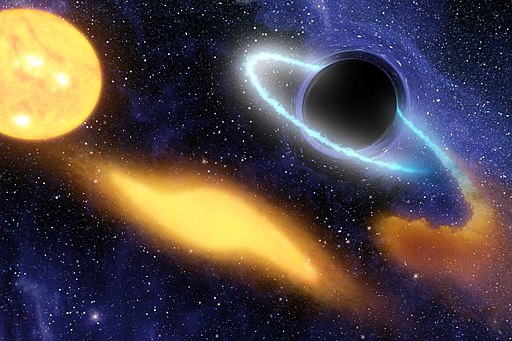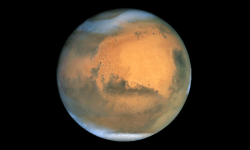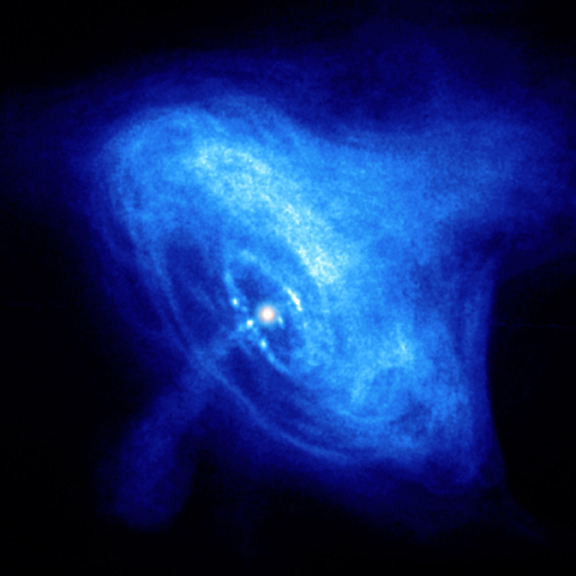
In recent years, there has been significant progress in the study of black holes. The first detections of gravitational waves made possible to know how they merge, an additional proof of their existence. In April 2019, the first image of the event horizon of a black hole was revealed by the Event Horizon Telescope. While 100 years ago we began to consider their theoretical existence, we are now certain of the physical reality of black holes.
But it would be wrong to believe that we have now understood everything about these cosmic monsters. We will never see what is happening behind the event horizon of a black hole, and we are still not sure how big they can be or how they work.
Detection of the smallest black hole so far
A team of American researchers has discovered the smallest black hole that has ever been detected, a black hole of about 3.3 solar masses. Black holes are usually discovered by the powerful X-ray, gamma-ray or radio-ray emissions from their accretion disk. But small black holes probably absorb less matter and therefore remain invisible because of their low radiation.
This mini black hole has been detected in a different way. It was discovered because it is part of a binary system. Its gravitational influence on the star that accompanies allowed to detect it. The researchers have discovered that this star has significant variations in radial velocity, which is the sign that it is dancing a gravitational waltz with another object.
A detection method borrowed from exoplanet hunters
Usually, this method is used to detect exoplanets but here the object responsible for this gravitational influence is too massive to be a planet. However, it is completely invisible in all parts of the light spectrum, which means that it is not a star either. This allowed us to deduce the presence of a black hole of low mass.
This discovery is important because it tells us that our current detection methods may not detect the presence of many black holes. All black holes that interact too weakly with the surrounding matter can not be detected by the radiation of this matter. In this case, new detection methods focused solely on the gravitational influence of black holes could help to better identify them.
Do even smaller black holes exist?
Finding small black holes is also a way to better understand massive stars and supernovas, which give rise to black holes or collapse into neutron stars. Typically, stellar black holes have a mass greater than 5 times the mass of the sun. Neutron stars have rarely more than 2.9 solar masses. Between these two masses, the border was blurred until the discovery of this mini black hole of 3.3 solar masses. We do not know yet if we will discover even smaller black holes.

A tiny black hole in the solar system?
For five years, some astronomers have speculated that there is a ninth planet in the solar system. They support this prediction on the observation of the trajectories of certain Transneptunian objects. These small planetoids orbit the sun at a great distance, much further than Neptune or even Pluto. Their orbits are highly elliptical, as if they had been disturbed by a massive object. But they are going too far from Neptune for this planet to be considered responsible.
This observation led a group of researchers to consider another orbital disruptor, an unknown planet evolving at a great distance from the sun and about 10 times more massive than the Earth. Since this assumption was issued in 2014, new extreme transneptunian objects have been discovered. They all have elliptical orbits but we still have not discovered a planet 9. The object is perhaps too difficult to observe because very far and very dark, or maybe it does not exist.
We can indeed imagine other mechanisms to explain the orbits of extreme transneptunians. Last week, two British and American researchers proposed a different solution to this problem. The disrupter of extreme transneptunians could be a black hole. The hypothesis is daring because it relies on the existence of a type of black hole that has never been detected. Indeed, to stick to the observed transneptunian orbits, this black hole should have a mass of five to ten times the mass of the Earth, which is far too little for a black hole. This black hole would not have formed after the collapse of the core of a massive star. The only possibility left is that it would be a primordial black hole.
This type of object whose existence is completely hypothetical would have formed at the very beginning of the universe. The matter was so dense that it could have collapsed locally to form the first black holes, which could be huge or tiny depending on the instability from which it came. The primordial black holes are one of the candidates for explaining dark matter. They could indeed be extremely numerous but also incredibly difficult to detect if they are small. If it exists, the black hole that orbits around the sun would for example be the size of a big ping pong ball.
The hypothesis of a primordial black hole, however, resolves some questions raised by the hypothesis of a ninth planet. If we admit that a ninth planet evolves 20 times farther from the sun than Neptune, we must explain why it exists. Regions as far away from a star are not conducive to planetary formation. It could be a wandering planet captured during the history of the solar system. But a primordial black hole would fit just as well.
Where the new hypothesis becomes interesting is that it proposes new research strategies. We do not detect a planet or a black hole in the same way. A primordial black hole could indeed emit detectable radiation by the FERMI or Chandra space observatories. Of course, it may just as well be a new chimera. Our planetary system may have neither a ninth planet nor a primordial black hole. However, it will be necessary to find a convincing explanation to the orbit of extreme transneptunians.
The black hole at the center of the galaxy NGC 3147 defies the models created by astronomers
– News of July 16, 2019 –
In April 2019, the first image of the event horizon of a black hole was revealed. On this image, we can see a shiny disk surrounding a central shadow area. We would like to be able to distinguish more details of this accretion disk and its borders, but this first image allows us at least to affirm that the general relativity seems to work very well to describe these celestial objects. We could almost believe that we are slowly beginning to understand black holes, but the universe is always full of surprises.
Thanks to the Hubble Space Telescope, a team of astronomers has just observed the center of galaxy NGC 3147 located about 130 million light-years away from home. Around what must be its central black hole, they detected a very thin disk in rapid rotation, at nearly 10% of the speed of light. The problem is that if we believe our models, this disk should not exist.
NGC 3147 is not a very active galaxy, so its central black hole does not have much to swallow. Normally, in this type of scenario we would expect the accretion disks to take on a puffy appearance, like a big donut around the black hole. This is exactly the model that astronomers hoped to confirm by leading this observation. Instead, they discovered what appears to be a very thin accretion disk, a scenario that we are used to seeing in galaxies at least a thousand times brighter.
Obviously, it will be necessary to revise the way in which we conceive the accretion disks of supermassive black holes in diffuse galaxies. Meanwhile, the black hole of NGC 3147 offers a fantastic opportunity to test special relativity and general relativity. The accretion disk seems anchored so deep in the gravitational well of the black hole that the light is struggling to escape. Using the spectrograph aboard Hubble, astronomers were able to analyze this light. It appears much brighter in one part of the accretion disk than in the other.
This is not due to an unequal distribution of matter, it is an effect that had been predicted by the special relativity. The source of light is moving very fast. The photons observed are therefore shifted to red or blue by the Doppler effect depending on whether their source is moving towards or away from us, giving us the impression that a part of the accretion disk of the hole black is brighter than the other. This was also the case on the black hole image produced by the Event Horizon Telescope.
All of the light that comes to us from the accretion disk is also strongly shifted to red. It is an indicator of its close proximity to the black hole and the difficulty it has had in escaping its power of attraction. Failing to fully understand the accretion disks of diffuse galaxies, we can at least confirm that the relativity is the right tool to look into the matter. The team of astronomers now hopes to see other very compact accretion disks surrounding supermassive black holes of not very active galaxies so they may be able to update their models.
The first image of a black hole will be revealed tomorrow
– News of April 9, 2019 –
Tomorrow, the Event Horizon Telescope project will finally reveal either the image of Sagittarius A *, or the image of a supermassive black hole located in the center of the Milky Way.
We may have seen the birth of a black hole or a neutron star !
– News of January 15, 2019 –
In June 2018, astronomers from around the world witnessed a huge explosion that occurred about 200 million light-years away in the constellation Hercules. A few weeks later, the object had lost much of its luminosity. Since, hypotheses accumulate to try to explain the exact nature of this cosmic event. Is it a particularly powerful supernova, a white dwarf brutally dislocated by a black hole, a magnetar or a gamma-ray burst ?
The object has been named AT2018COW. It appeared much brighter than a normal supernova, and above all it lit and calmed down in record time. It only took a few days for it to reach its peak of brightness and another 16 days to lose much of its brightness.
An international team in collaboration with the Keck observatory thank about the source of this event. They combined X-ray, visible light, infrared and radio observations from several observatories. They realized that this cataclysmic event propelled matter to almost 10% of the speed of light, and discovered what was hidden in the heart of this explosion. They are almost sure that the explosion observed during the summer of 2018 is the formation of a black hole or a neutron star.
This is the first time that such an event can be followed virtually live. Black holes and neutron stars are formed when a giant star dies. When the thermonuclear fuel is exhausted, the heart of these stars collapses in an instant under the effect of its own gravity. The outer layers of the star are blown into a gigantic explosion and it remains only one object of very high density in the center, a neutron star or in the most extreme cases a black hole.
We do not yet know which of these two objects was born at the heart of AT2018COW but it is the ideal opportunity to dive into the complex physics that accompany their birth. When you observe a neutron star, it is generally already a few hundred years old, if you are lucky.
The observations of AT2018COW were facilitated by several things. First, the explosion expelled much less material than when a typical massive star died. With ten times less debris in front of their telescopes, astronomers could directly observe the radiation of the central object. On the other hand, 200 million light-years is a small distance on the cosmic scale. Other similar objects could therefore will be discovered.
The observation of AT2018COW is a striking example of the growing importance of speed in astronomy. Many of the most interesting events in the universe are ephemeral. In order to be able to observe them in the best conditions, observatories must be mobilized very quickly before these events can be completed. For example, this is important to be quick to be able to identify optical signals with gravitational wave detections. This is a new area of progress for observatories around the world that does not involve better instruments but better organization and collaboration. This is the necessary condition for being able to dive into the heart of the most violent events in the universe.
Black holes will disappear after stars and galaxies
– News of November 4, 2018 –
Stephen Hawking predicted that black holes can evaporate and disappear. At the edge of their event horizon, radiation should form the Hawking radiation. This radiation cannibalize the mass of a black hole until its complete evaporation. However, it is an extremely weak radiation. The evaporation process would therefore be very long for most black holes. It would actually start when the universe itself will be very old and cold. Black holes could then emit more radiation than they absorb and begin to lose mass.
For a black hole of the mass of the sun, it would take around 1064 years for total evaporation. The most massive black holes in the universe may require up to 10106 years to evaporate. These are so huge numbers that it’s almost impossible to imagine. If Stephen Hawking is right, long after all the stars and all the galaxies are gone, the universe will be dominated by black holes slowly evaporating. They will also eventually disappear, leaving a great void traveled by a few particles.
Image by ESO









